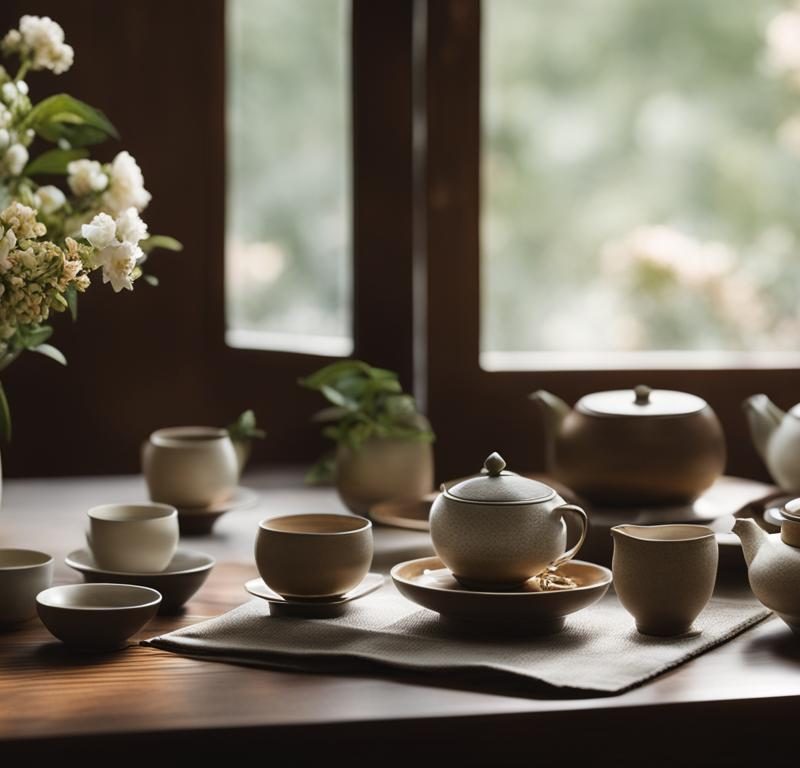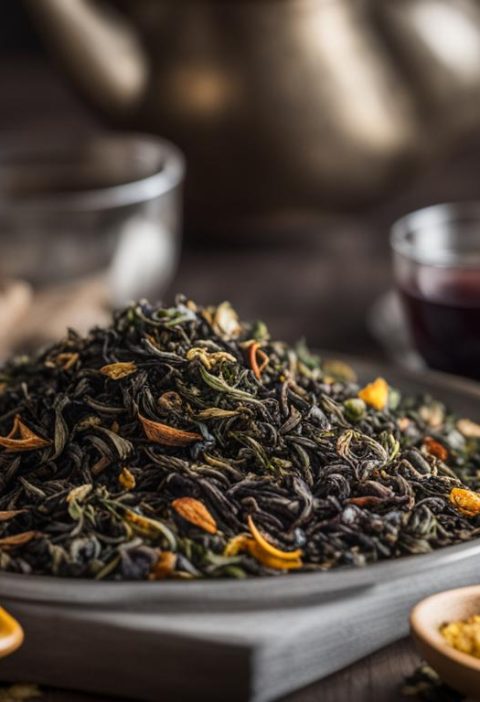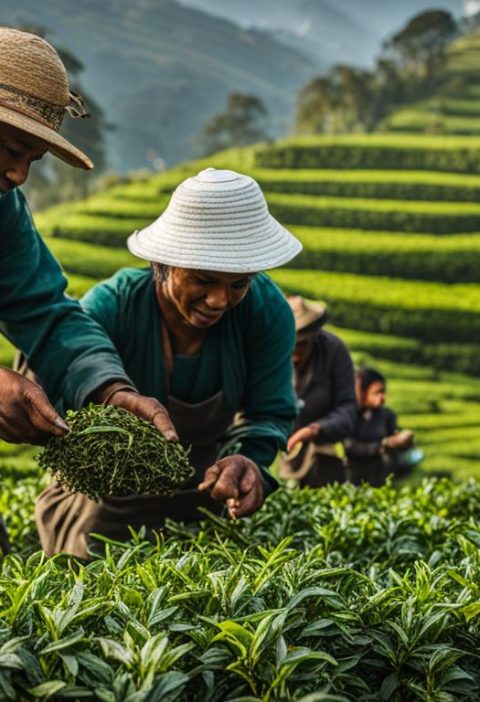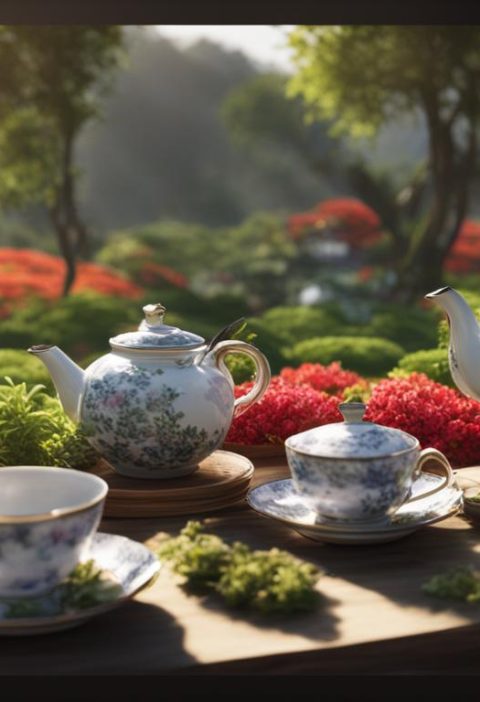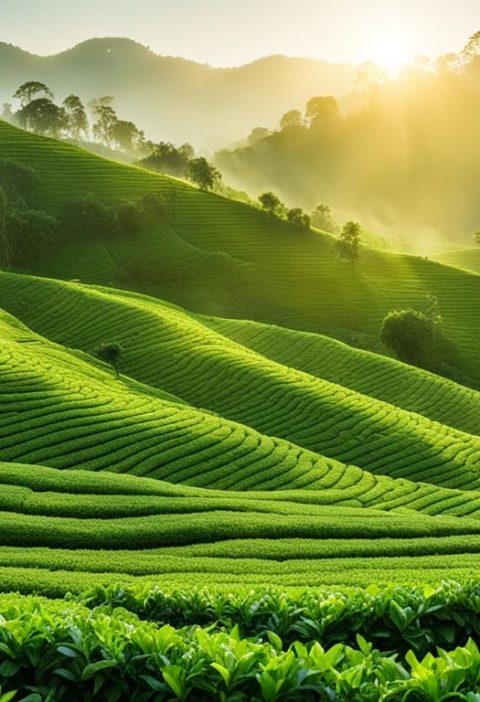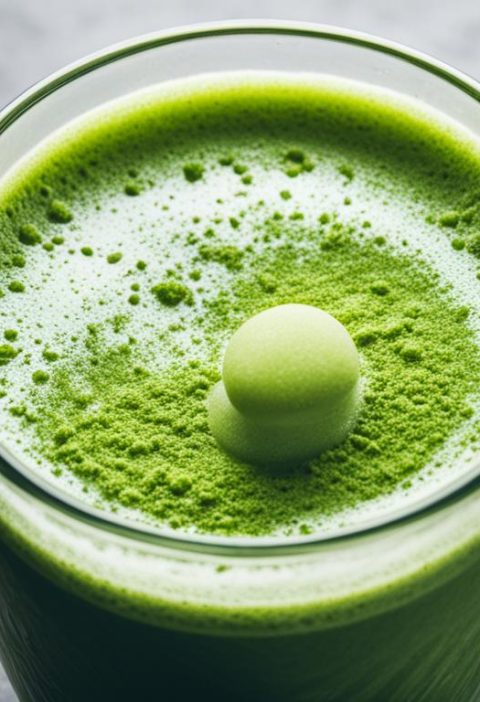The tea ceremony is a beautiful and time-honored tradition that can be enjoyed by all. However, the cost of tea ceremony essentials can add up quickly. That’s why I’m here to share with you some essential tips for saving money on tea ceremony supplies, tools, equipment, and accessories. With these cost-effective strategies, you can embrace the beauty of the tea ceremony without breaking the bank. So, let’s dive in and discover how to make your tea ceremony experience both memorable and budget-friendly.
Key Takeaways:
- Save on tea ceremony essentials by opting for cost-effective supplies.
- Look for budget-friendly tools and equipment that still meet your quality needs.
- Consider affordable accessories that complement the tea ceremony experience.
- Find economical items that provide value without compromising on tradition.
- Explore different ways to save on tea ceremony necessities without sacrificing the beauty of the ceremony.
Understanding the Chinese Tea Ceremony
The Chinese tea ceremony is a captivating display of Chinese tea culture that encompasses tea preparation, ritual framework, individual arrangement, and the use of specific tools and facilities. Rooted in tradition and situational context, this ceremonial practice aims to achieve harmony and balance between the participants and the natural world.
The Chinese tea ceremony focuses on the interplay of core elements, including wood, fire, earth, metal, and water, representing the fundamental forces of nature. These elements are brought together in a Taoist-inspired framework that also incorporates the Taoist elements of sky, human, and earth. Additionally, the Chinese tea ceremony reflects the influence of Confucian and Buddhist philosophies.
By understanding these elements and their significance, participants can deepen their appreciation for the tea ceremony’s profound beauty and spiritual connection. The diligent arrangement of the ceremony and its adherence to established protocols infuse the practice with a sense of reverence and intention.
To illustrate the importance of these elements and their impact on the ceremony, we have compiled a table summarizing the core elements and their associations within the Chinese tea ceremony:
| Element | Associations |
|---|---|
| Wood | Growth, vitality, and flexibility |
| Fire | Transformation, warmth, and energy |
| Earth | Nourishment, stability, and grounding |
| Metal | Purity, clarity, and refinement |
| Water | Flow, adaptability, and calmness |
The Chinese tea ceremony acts as a conduit for the harmonious union of these core elements, resulting in a sensory and spiritual experience. By seamlessly integrating Taoist, Confucian, and Buddhist influences, this time-honored tradition offers a profound way to connect with Chinese culture and appreciate the beauty found within the act of tea preparation.
Essential Elements of the Chinese Tea Ceremony
Within the Chinese tea ceremony, specific tools and facilities play a crucial role in creating the desired ambiance and facilitating the tea preparation process. Here are several essential elements commonly associated with the Chinese tea ceremony:
- Tea table: The tea table serves as the central platform for the ritual, providing a designated space for the tea preparation and presentation.
- Teapot: Often crafted with meticulous attention to detail, the teapot is entrusted with the essential task of steeping and pouring the tea.
- Teacups: The vessel through which tea is shared and appreciated, teacups come in various sizes and designs to enhance the drinking experience.
- Tea utensils: These include tools such as tea scoops, tongs, and strainers, each carefully selected for their contribution to the ritual and overall aesthetics.
- Tea leaves: The selection of high-quality tea leaves is essential for achieving the desired flavors and aromas during the ceremony.
By embracing the core elements and utilizing the appropriate tools and facilities, participants can create an environment conducive to mindfulness, reflection, and unity with nature. The Chinese tea ceremony invites individuals to immerse themselves in a practice where time slows down, promoting an appreciation for the finer details and a deep connection with the present moment.
The Tools of the Tea Ceremony
This section delves into the essential tools required for a proper tea ceremony. Each item serves a specific purpose and contributes to the overall experience and aesthetics of the ritual.
Tea Table: The Elegant Base of the Ceremony
The tea table, also referred to as the tea boat, acts as the platform for the ceremonial actions. Crafted from wood, it represents the element of nature and serves as a work of art and ornament in itself.
Teapot: Masterful Craftsmanship and Aesthetics
The teapot is a crucial tool in the tea ceremony, determining the quality of the brew. Factors such as pouring behavior, outflow path, material properties, craftsmanship, and aesthetics play significant roles in selecting the perfect teapot.
Teacup: Enhancing the Aroma and Delight
The teacup holds an important place in the tea ceremony, contributing to the visual and sensory experience. Aroma tea cup sets, often used in the ceremony, allow for the degustation of multiple infusions and enhance the exploration of different aromas.
| Tool | Description |
|---|---|
| Tea Table | Serves as the platform for ceremonial actions, crafted from wood, and an ornament in itself. |
| Teapot | An essential tool for brewing tea, with factors such as pouring behavior, outflow path, material properties, craftsmanship, and aesthetics determining its quality. |
| Teacup | Plays a crucial role in the ceremony, allowing for the appreciation of aroma and exploration of different tea infusions. |
Understanding the significance of these tools enhances the reverence and experience of the tea ceremony. The craftsmanship and attention to detail exemplified in these tools elevate the art of tea preparation to new heights, creating a memorable and immersive experience.
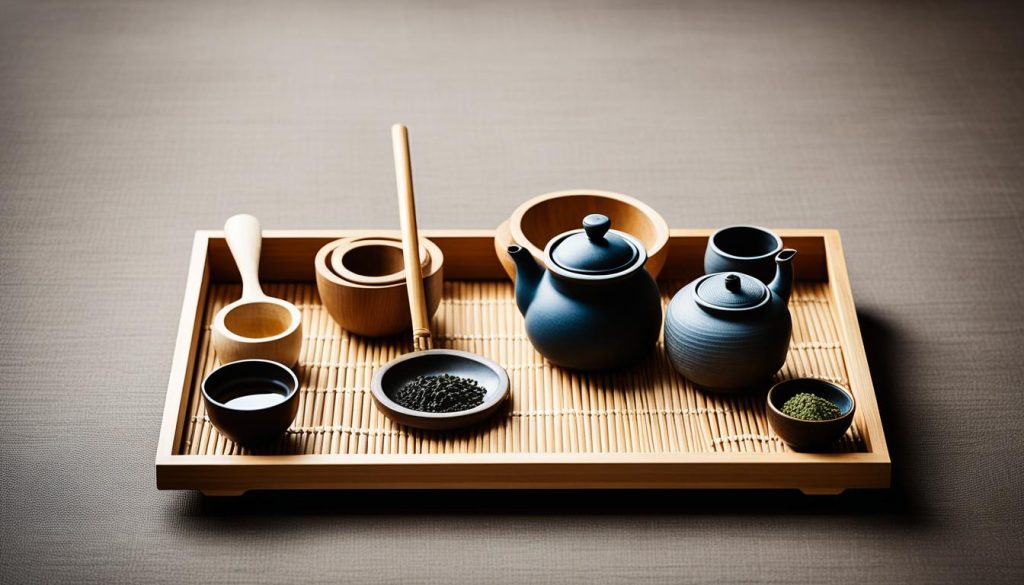
Exploring Herbal Tea Ceremonies
Herbal tea ceremonies are a wonderful way to connect with nature and discover the everyday beauty that surrounds us. These ceremonies invite us to slow down, be present, and savor the flavors and benefits of herbal teas. Whether you choose to hold a personal ceremony or gather with friends and family, engaging in an herbal tea ceremony can bring a sense of calm, mindfulness, and heartfelt connection to your life.
Plant allies play a significant role in herbal tea ceremonies. As we sip on these aromatic concoctions, we forge a deeper connection with the natural world and appreciate the abundance of healing properties that plants provide. Each cup of herbal tea becomes a simple act of pleasure, allowing us to take time out of our busy lives and indulge in a mid-day break of relaxation and mindful presence.
Herbal tea ceremonies encourage us to focus on the present moment and find solace in the everyday beauty that surrounds us. Whether it’s the gentle infusion of chamomile blossoms or the invigorating blend of peppermint leaves, each sip transports us to a world of sensory delight. These ceremonies serve as a reminder to appreciate the little things in life and find joy in the simple acts of self-care.
Next time you feel overwhelmed or in need of a moment of tranquility, consider diving into the world of herbal tea ceremonies. Create a serene atmosphere, gather your favorite herbal teas, and take a moment to immerse yourself in the beauty and serenity that herbal tea ceremonies offer.
The Rich History of Tea
Tea has a rich history that spans thousands of years. It originated in China, where legends recount the accidental discovery of tea by Emperor Shen Nong. Tea has been cherished for its health benefits, including antioxidant properties and mood-enhancing effects. Different tea cultures, such as the Chinese tea ceremony and the Japanese tea ceremony, have evolved over time, each with its unique flavors, rituals, and traditions. Tea has been enjoyed by samurai warriors and Zen Buddhist monks, highlighting its importance in various cultures and traditions.
Tea is not just a simple beverage; it has a fascinating origin that dates back to ancient times. Legends tell the tale of Emperor Shen Nong, also known as the “Divine Farmer,” who discovered tea when a tea leaf accidentally fell into his boiling water. Intrigued by the aroma and taste, the emperor began to explore the potential health benefits of tea.
As time passed, tea became more than just a drink. It became a symbol of culture and tradition, with various tea ceremonies and rituals evolving into beautiful and meaningful practices. In China, the tea ceremony became an integral part of social interactions, emphasizing harmony and mindfulness. The Chinese tea ceremony incorporates elements of Taoist philosophy and the teachings of Confucius and Buddha.
Similarly, the Japanese tea ceremony, known as “Chanoyu” or “Sado,” holds deep cultural significance. Influenced by Zen Buddhism, this ceremony focuses on simplicity, respect, and the appreciation of nature. The Japanese tea ceremony also features specific rituals and gestures that add to the overall experience.
Tea has transcended borders and cultures, captivating people all over the world. From the bold and robust flavors of black tea to the delicate and nuanced flavors of green tea and oolong tea, there is a tea for every palate. Each tea variety has its own unique preparation method, brewing time, and serving style.
Tea rituals are not limited to China and Japan. Different countries and regions have their own tea cultures and customs. From the elaborate Chinese tea ceremony to the traditional British afternoon tea, tea has become an integral part of many societies.
The rich history of tea continues to influence our modern lives. The health benefits of tea, such as its antioxidant properties and calming effects, have been celebrated for centuries. Moreover, tea has been appreciated by a diverse range of individuals, from samurai warriors to Zen Buddhist monks, emphasizing its significance across different traditions and lifestyles.
Whether you prefer a soothing cup of green tea, a robust black tea, or the aged complexity of pu’erh tea, exploring the world of tea opens up a world of flavors, cultures, and traditions. As you savor each sip, take a moment to appreciate the centuries of craftsmanship, rituals, and stories that have shaped the beautiful tapestry of tea.
Explore the origins of tea in the next section as we dive deeper into the legends and historical significance surrounding this beloved beverage.
The Beauty of Matcha
Matcha is a traditional Japanese tea that has gained popularity worldwide, and its versatility extends beyond the tea cup. From matcha lattes to baked goods, matcha’s vibrant green color and unique flavor have captivated the taste buds of many. But what sets matcha apart? Let’s explore the beauty and benefits of this cherished tea.
When you enjoy a cup of matcha, prepare yourself for more than just a delightful taste. Matcha is known to provide mental clarity, expanded awareness, relaxation, and heightened focus. The combination of amino acids, specifically L-theanine, found in matcha promotes a sense of calm alertness, creating the perfect balance between relaxation and heightened concentration.
One of the remarkable features of matcha is the high concentration of chlorophyll, which gives it its vibrant green color. This natural pigment not only adds visual appeal to your cup, but it also provides health benefits. Chlorophyll is known for its detoxifying and antioxidant properties, helping to rid your body of harmful toxins and support overall well-being.
Speaking of antioxidants, matcha boasts an impressive amount of these powerful substances. The catechins found in matcha, particularly epigallocatechin gallate (EGCG), are a potent type of antioxidant that helps protect cells from damage caused by free radicals. These antioxidants contribute to the numerous health benefits associated with matcha consumption, including improved heart health, strengthened immune system, and potential cancer-fighting properties.
Unlike regular green tea, matcha is consumed in powdered form, ensuring that you consume the entire leaf and all its nutrients. This makes matcha a powerhouse of beneficial compounds, offering more health benefits compared to steeped green tea leaves.
Matcha is available in different grades, each with its own characteristics and uses. The highest quality matcha is ceremonial grade, used in traditional tea ceremonies. Its vibrant color, smooth texture, and delicate flavor make it perfect for whisking into a frothy cup of matcha or as an ingredient in culinary creations.
Premium grade matcha offers a slightly more robust flavor while still maintaining a vibrant green color. It is ideal for enjoying as a tea or adding depth to your matcha-infused recipes.
For those looking to explore matcha’s culinary possibilities, there is culinary grade matcha. This grade has a more robust flavor profile and is often used in cooking, baking, and blending into smoothies or lattes.
If you prefer to savor matcha while being mindful of the environment, organic matcha is a great choice. Produced without the use of pesticides or synthetic fertilizers, organic matcha ensures a pure and natural experience.
Discover the beauty and benefits of matcha with these tips and recommendations. Whether you’re seeking mental clarity, a moment of relaxation, or a health-conscious beverage, matcha has something to offer. So take a sip and indulge in the wonders of this traditional Japanese tea.
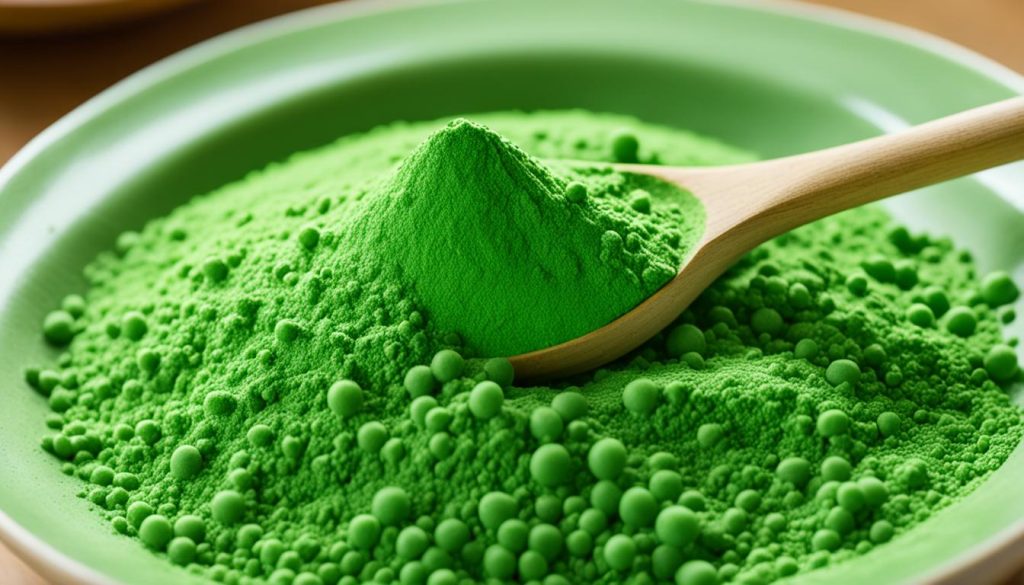
| Grade | Description | Usage |
|---|---|---|
| Ceremonial Grade | High-quality matcha used in traditional tea ceremonies | Whisked into a frothy cup of tea, culinary creations |
| Premium Grade | Slightly more robust flavor with a vibrant green color | Enjoying as a tea, matcha-infused recipes |
| Culinary Grade | Robust flavor profile, ideal for cooking and blending | Cooking, baking, blending into smoothies or lattes |
| Organic Matcha | Produced without pesticides or synthetic fertilizers | A pure and natural matcha experience |
How Matcha is Grown and Harvested
Matcha, the vibrant green powdered tea renowned for its health benefits, is made from specially cultivated green tea leaves. The process begins with matcha cultivation, where the tea plants are carefully grown to maximize their flavor and nutritional content.
Green tea leaves destined for matcha production undergo a unique shading process. About three weeks before harvesting, the tea plants are shaded from direct sunlight. This shading stimulates the growth of chlorophyll-rich leaves, resulting in a vibrant green color and a higher concentration of nutrients.
When the leaves reach their peak, they are hand-plucked carefully to ensure only the finest buds are selected. These tender buds are then dried and stripped of veins and stems, leaving behind only the purest leaves full of essential nutrients.
Once the leaves are ready, they are ground into a fine powder using traditional stone mills. This meticulous grinding process preserves the tea’s natural flavors, vibrant color, and rich aromas.
Most matcha is sourced from two regions in Japan known for their tea cultivation: Uji, the historical tea capital near Kyoto, and the Yame district in Fukuoka. These regions have a long-standing tradition of producing high-quality matcha, ensuring authenticity and superior taste.
Matcha cultivation involves growing shade-grown green tea leaves that are hand-picked, dried, and finely ground into a powder. The process enhances the tea’s nutritional benefits and results in vibrant and flavorful matcha.
| Benefits of Matcha | How Matcha Cultivation Enhances These Benefits |
|---|---|
| Boosts immune system | The shading process increases the concentration of antioxidants, strengthening the immune system. |
| Lowers cholesterol | Matcha consumption has shown promising results in reducing LDL cholesterol levels. |
| Supports detoxification | The high chlorophyll content in matcha aids in detoxification and cleansing the body. |
| Aids in weight loss | Matcha can boost metabolism and help burn calories, supporting weight loss efforts. |
| Provides anti-aging skincare | The antioxidants in matcha help fight free radicals, promoting healthy skin and slowing down the aging process. |
Matcha cultivation is not only a meticulous process but also a labor of love. The result is a vibrant and flavorful tea that offers numerous health benefits for both the mind and body.
Grades of Matcha and Organic Options
Matcha, a beloved traditional Japanese tea, comes in different grades that determine its quality and intended use. Whether you’re looking for a matcha for tea ceremonies or culinary endeavors, understanding the various options can help you make the right choice. Additionally, there is a growing interest in organic matcha, with discussions surrounding its flavor and quality compared to conventional matcha.
Let’s explore the different grades of matcha and organic options:
Ceremonial Grade Matcha
Ceremonial grade matcha is the highest quality available, crafted specifically for tea ceremonies and Buddhist temples. Grown with meticulous care, these shade-grown leaves are stone-ground into a fine powder, resulting in a vibrant green color and a smooth, rich flavor. Ceremonial grade matcha is renowned for its exceptional powder quality and is treasured for its unmistakable taste and aroma.
Premium Grade Matcha
Premium grade matcha is slightly lower in quality compared to ceremonial grade matcha but still maintains a high standard. It offers an excellent balance between flavor, texture, and affordability. This grade is commonly used in everyday matcha consumption, whether enjoyed traditionally or in matcha lattes, smoothies, and culinary creations.
Culinary Grade Matcha
Culinary grade matcha, while coarser in texture, is perfect for cooking, blending, and baking. Its robust flavor adds depth and richness to a wide range of recipes, including desserts, confections, and savory dishes. This grade of matcha is ideal for those who want to experiment with matcha-infused creations in their culinary adventures.
Organic Matcha
Organic matcha is grown without the use of harmful fertilizers and pesticides, providing a natural and environmentally friendly option. However, debates regarding the flavor and quality of organic matcha compared to conventional varieties still exist. It’s crucial to choose organic matcha from reputable brands to ensure the authenticity and provenance of your matcha.
When sourcing matcha, consider trusted brands like Mizuba Tea Co. and Spirit Tea, known for their commitment to high-quality matcha and sustainable practices. By choosing the right grade and exploring organic options, you can enjoy the unique flavors and health benefits that matcha offers.
| Grade | Quality | Intended Use |
|---|---|---|
| Ceremonial | Highest quality | Tea ceremonies, Buddhist temples |
| Premium | High standard | Everyday matcha consumption, matcha lattes |
| Culinary | Coarser texture | Cooking, blending, baking |
| Organic | Varies | Depends on brand and provenance |
The Art of Japanese Tea Ceremony
The Japanese tea ceremony is a 900-year-old tradition that goes beyond a simple act of preparing and drinking tea. It is a deeply spiritual practice that embodies principles of spirituality, respect, and tradition. In the tea ceremony, every action is performed with thoughtfulness and mindfulness, creating a sense of harmony and tranquility.
The Urasenke and Omotesenke schools are renowned for their teachings in the art of the Japanese tea ceremony. These schools have preserved and passed down the rituals and techniques from generation to generation, ensuring the continuity of this ancient tradition.
Central to the tea ceremony are the various tools used in the process. The chasen, a bamboo whisk, is used to whisk the powdered matcha to a frothy consistency, while the chashaku, a bamboo scoop, is used to measure and transfer the matcha powder. The matcha bowl is an essential vessel for preparing and serving the tea, and a mesh strainer ensures a smooth and clump-free infusion. Proper storage of matcha is crucial to maintain its freshness and flavor.
Attending tea events and learning about the tea ceremony can provide a deeper understanding of its significance as a form of meditation and respite in our fast-paced world. The tea ceremony allows us to pause, reflect, and find solace in a moment of calmness. It is an invitation to connect with ourselves, others, and the 900-year-old tradition that continues to inspire and captivate tea enthusiasts worldwide.
